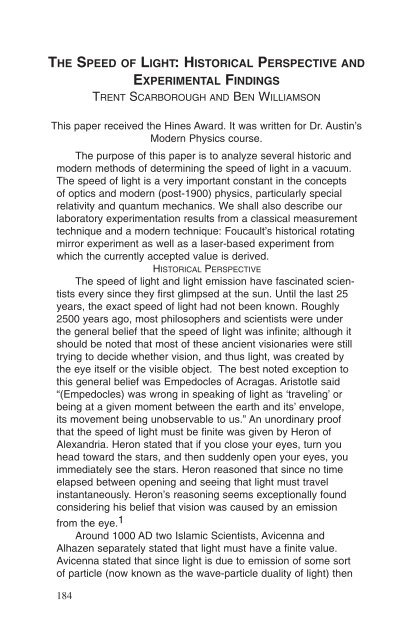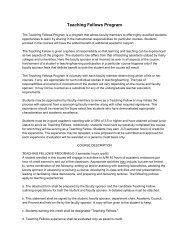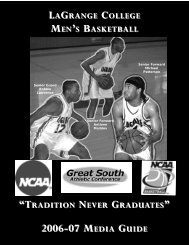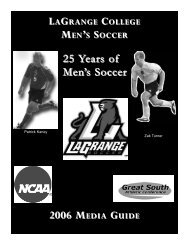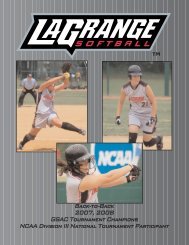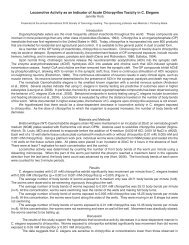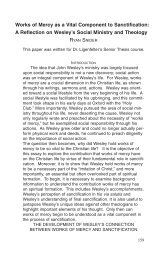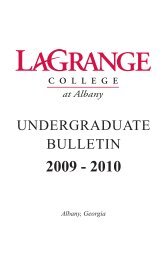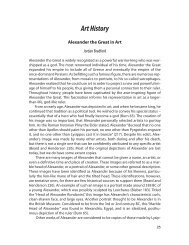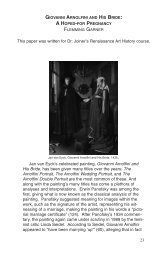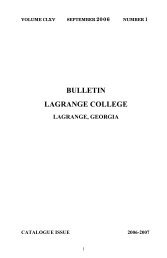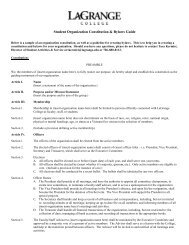The Speed of Light: Historical Perspective and Experimental Findings
The Speed of Light: Historical Perspective and Experimental Findings
The Speed of Light: Historical Perspective and Experimental Findings
You also want an ePaper? Increase the reach of your titles
YUMPU automatically turns print PDFs into web optimized ePapers that Google loves.
THE SPEED OF LIGHT: HISTORICAL PERSPECTIVE AND<br />
EXPERIMENTAL FINDINGS<br />
TRENT SCARBOROUGH AND BEN WILLIAMSON<br />
This paper received the Hines Award. It was written for Dr. Austin’s<br />
Modern Physics course.<br />
<strong>The</strong> purpose <strong>of</strong> this paper is to analyze several historic <strong>and</strong><br />
modern methods <strong>of</strong> determining the speed <strong>of</strong> light in a vacuum.<br />
<strong>The</strong> speed <strong>of</strong> light is a very important constant in the concepts<br />
<strong>of</strong> optics <strong>and</strong> modern (post-1900) physics, particularly special<br />
relativity <strong>and</strong> quantum mechanics. We shall also describe our<br />
laboratory experimentation results from a classical measurement<br />
technique <strong>and</strong> a modern technique: Foucault’s historical rotating<br />
mirror experiment as well as a laser-based experiment from<br />
which the currently accepted value is derived.<br />
HISTORICAL PERSPECTIVE<br />
<strong>The</strong> speed <strong>of</strong> light <strong>and</strong> light emission have fascinated scientists<br />
every since they first glimpsed at the sun. Until the last 25<br />
years, the exact speed <strong>of</strong> light had not been known. Roughly<br />
2500 years ago, most philosophers <strong>and</strong> scientists were under<br />
the general belief that the speed <strong>of</strong> light was infinite; although it<br />
should be noted that most <strong>of</strong> these ancient visionaries were still<br />
trying to decide whether vision, <strong>and</strong> thus light, was created by<br />
the eye itself or the visible object. <strong>The</strong> best noted exception to<br />
this general belief was Empedocles <strong>of</strong> Acragas. Aristotle said<br />
“(Empedocles) was wrong in speaking <strong>of</strong> light as ‘traveling’ or<br />
being at a given moment between the earth <strong>and</strong> its’ envelope,<br />
its movement being unobservable to us.” An unordinary pro<strong>of</strong><br />
that the speed <strong>of</strong> light must be finite was given by Heron <strong>of</strong><br />
Alex<strong>and</strong>ria. Heron stated that if you close your eyes, turn you<br />
head toward the stars, <strong>and</strong> then suddenly open your eyes, you<br />
immediately see the stars. Heron reasoned that since no time<br />
elapsed between opening <strong>and</strong> seeing that light must travel<br />
instantaneously. Heron’s reasoning seems exceptionally found<br />
considering his belief that vision was caused by an emission<br />
from the eye. 1<br />
Around 1000 AD two Islamic Scientists, Avicenna <strong>and</strong><br />
Alhazen separately stated that light must have a finite value.<br />
Avicenna stated that since light is due to emission <strong>of</strong> some sort<br />
<strong>of</strong> particle (now known as the wave-particle duality <strong>of</strong> light) then<br />
184
TRENT SCARBOROUGH AND BEN WILLIAMSON<br />
the speed <strong>of</strong> light must be finite. Alhazen affirmed that light is<br />
movement; therefore it is at one instant in one place <strong>and</strong> at<br />
another instant in another place. Since it is impossible for light<br />
to be in both places at the same time, the transmission <strong>of</strong> light<br />
cannot be instantaneous. Sir Francis Bacon stated in 1620<br />
“Even in sight, where<strong>of</strong> the action is most rapid, it appears that<br />
there are required certain moments <strong>of</strong> time for its accomplishment…<br />
[for there are] things which by reason <strong>of</strong> the velocity <strong>of</strong><br />
motion cannot be seen – as when a ball is discharged from a<br />
musket…” <strong>The</strong>re was still uncertainty seen by Bacon’s contemporary,<br />
Johann Kepler. Kepler was famous for his work on planetary<br />
motion. Kepler reasoned that since light could be propagated<br />
into illimitable space, it required no time. Since light did<br />
not need time, it was immaterial <strong>and</strong> could <strong>of</strong>fer no resistance to<br />
a moving force. Thus according to Aristotelian mechanics (a now<br />
archaic form <strong>of</strong> mechanics that would be superseded by<br />
Newtonian mechanics at least 40 years after Kepler’s death)<br />
light must have an infinite velocity. 2<br />
<strong>The</strong> First Experiments to Determine the <strong>Speed</strong> <strong>of</strong> <strong>Light</strong><br />
A contemporary <strong>of</strong> Kepler <strong>and</strong> Bacon, was Galileo Galilee.<br />
Galileo was the first person to actually attempt to measure the<br />
speed <strong>of</strong> light. Galileo devised that two people should go st<strong>and</strong><br />
with covered lanterns a known distance apart. When one uncovered<br />
their lantern, the other would quickly uncover his lantern<br />
<strong>and</strong> the time difference would be measured. After testing this<br />
experiment at a distance less than one mile, Galileo concluded:<br />
“I have not been able to ascertain with certainty whether the<br />
appearance <strong>of</strong> the opposite light was instantaneous or not; but if<br />
not instantaneous it is extraordinarily rapid – I should call it<br />
momentary.” 2 It could be said that Galileo at least established a<br />
lower limit for the speed <strong>of</strong> light. It is known today that about a<br />
thirtieth <strong>of</strong> a second is the minimum time interval distinguishable<br />
by the unaided, human eye. <strong>The</strong>n Galileo’s experiment put a lower<br />
limit <strong>of</strong> about 9.65 x 10 4 meters per second (m/s) on the speed <strong>of</strong><br />
light; which is about 3000 times less than the currently accepted value.<br />
Renee Descartes sought to get an actual number by greatly increasing<br />
the distance. Descartes proposed that if light was finite with time<br />
than eclipses <strong>of</strong> the moon would be visible on earth later than when<br />
the sun, moon <strong>and</strong> earth were calculated to be in a straight line. When<br />
no delay was detected, Descartes proceeded to declare that light<br />
must be instantaneous. 3<br />
185
THE SPEED OF LIGHT<br />
Given the failure <strong>of</strong> Galileo <strong>and</strong> Descartes, Ole Roemer<br />
sought to determine the velocity <strong>of</strong> light by observing even further<br />
distances. Roemer studied the eclipses <strong>of</strong> Jupiter’s moon,<br />
Io. Roemer timed the moment that Io became hidden by Jupiter<br />
<strong>and</strong> then the moment that it reappeared. He would then compare<br />
this time interval as Earth moved closer <strong>and</strong> further away<br />
from Jupiter. Roemer realized that as Earth moved away from<br />
Jupiter, the time interval for time spent hidden increased. As<br />
earth rotated back closer to Jupiter, the hidden time interval<br />
would slowly decrease. Although Roemer himself never actually<br />
gave a numerical value for the speed <strong>of</strong> light, he did state that<br />
light requires about a second (s) <strong>of</strong> time to traverse a distance<br />
equal to the diameter <strong>of</strong> the earth. From this statement it can be<br />
deduced that light would require 22 minutes to traverse the<br />
earth’s orbit. 3 <strong>The</strong>se numbers were combined by Christian<br />
Huygens to give the value <strong>of</strong> 2.20 x 10 8 m/s which gives a percent<br />
error <strong>of</strong> about 26% from the currently accepted value. 1<br />
Although the value is inaccurate, it was the first reproducible<br />
result for the speed <strong>of</strong> light <strong>and</strong> gave pro<strong>of</strong> that the speed <strong>of</strong><br />
light was finite.<br />
For the next 150 years people would continue to adapt<br />
Roemer’s experiment <strong>and</strong> come up with a multitude <strong>of</strong> values<br />
for the speed <strong>of</strong> light. Even Isaac Newton attempted to determine<br />
the speed <strong>of</strong> light <strong>and</strong> predicted it to be about 2.41x 10 8<br />
m/s. Newton derived his speed using Cassini’s value for the<br />
retardation <strong>of</strong> light from the sun <strong>and</strong> his own guess that the distance<br />
from the earth to the sun was approximately 1.12 x 10 11<br />
meters (m). If Newton had used Cassini’s own value for the distance<br />
from the earth to the sun, 1.46 x 10 11 m, he would have<br />
arrived at a speed <strong>of</strong> light <strong>of</strong> approximately 3.05 x 10 8 m/s, only<br />
a 2 percent error from the now accepted value. 3<br />
Up until the 1840s, no one had been able to determine an<br />
accurate measurement for the speed <strong>of</strong> light using only terrestrial<br />
measurements. In 1849, Arm<strong>and</strong> Fizeau sought to remedy<br />
this problem. Fizeau set up a rotating cog wheel with 720 teeth<br />
spinning at 12.6 revolutions per second (rev/s). Fizeau sent a<br />
lamp beam through the teeth <strong>and</strong> then 8 kilometers (10 3 m)<br />
away to a mirror. Upon returning, the beam was brought though<br />
the gaps <strong>of</strong> the teeth. As the light passed through the gaps on<br />
186
TRENT SCARBOROUGH AND BEN WILLIAMSON<br />
their return, the light was blocked by the teeth as they moved<br />
into the position <strong>of</strong> the gaps. <strong>The</strong> time taken for the teeth to<br />
move this distance was equal to the time taken for the light to<br />
travel to the mirror <strong>and</strong> back, 16 km. Using simple math he<br />
obtained a value <strong>of</strong> 3.15 x 10 8 m/s; roughly 5% too high. 4<br />
Fizeau’s former friend/partner Leon Foucault would use the<br />
same concept in 1862 except with a spinning mirror <strong>and</strong> determine<br />
the speed <strong>of</strong> light to be 2.98 x 10 8 m/s, within 1% <strong>of</strong> the<br />
correct value. 5<br />
An important revelation came about near the end <strong>of</strong> the<br />
nineteenth century. At the time, the theory <strong>of</strong> light acting as a<br />
wave was well accepted by the scientific community, thanks to<br />
the earlier work <strong>of</strong> Thomas Young <strong>and</strong> Augustin Fresnel.<br />
However, there was a troubling problem in the conventional<br />
logic: If light is a wave, then there must exist some form <strong>of</strong><br />
medium upon which it travels, as all other known waves did<br />
have a medium <strong>of</strong> transmission. In 1873, James Clerk Maxwell<br />
used his electromagnetic theory <strong>of</strong> light to determine the speed<br />
<strong>of</strong> light in a vacuum mathematically (See appendix 1 for a derivation):<br />
where _ o <strong>and</strong> _ 0 are the permeability<br />
<strong>and</strong> permittivity <strong>of</strong> free space, respectively. 6 He proposed<br />
that such a medium, called the “luminiferous ether” must<br />
be consistent with electromagnetic theory <strong>and</strong> that a sensitive<br />
enough instrument could discern its properties. By 1880, the<br />
concept <strong>of</strong> the ether was well accepted. 7<br />
Finding this mysterious ether became the next goal <strong>of</strong><br />
physics, <strong>and</strong> in the 1880’s, a famous experiment known as the<br />
Michelson-Morley Experiment would yield startling results. Albert<br />
Michelson developed an extremely precise instrument called the<br />
interferometer, which could detect very small phase differences<br />
between two light waves. His device used an incident beam <strong>of</strong><br />
monochromatic light partially reflected <strong>and</strong> partially transmitted<br />
by a silvered glass surface. <strong>The</strong> light is then reflected by two<br />
mirrors at perpendicular angles (the theory being that one <strong>of</strong> the<br />
paths <strong>of</strong> light will be parallel to the Earth’s motion through the<br />
ether flow <strong>and</strong> one will be perpendicular, so there will be a<br />
phase difference between the two beams). Using classical<br />
mechanics he determined that there should be a time difference<br />
187
THE SPEED OF LIGHT<br />
between the two beams <strong>of</strong> 8 x 10 -17 s, which would result in<br />
0.04 fringes in the interference pattern. Though his instrument<br />
should have been able to detect a pattern half the size <strong>of</strong> the<br />
expected result, he found nothing. In 1887, Michelson teamed<br />
up with Edward Morley, who would make great improvements on<br />
Michelson’s device. <strong>The</strong> path length <strong>of</strong> the device was greatly<br />
extended, increasing the expected fringe shift tenfold. Even<br />
though the device could detect a fringe shift as small as 0.005,<br />
they observed absolutely no effect. <strong>The</strong> results were consistent<br />
over several subsequent retrials, <strong>and</strong> no substantial results were<br />
ever observed. <strong>The</strong> ether did not seem to exist. Today, over a<br />
century later, there is still no realistic evidence for the ether theory.<br />
7 Albert Michelson would then improve on Foucault’s apparatus<br />
by using better optical lenses <strong>and</strong> a longer baseline for the<br />
distance. Beginning in 1906, Michelson measured the speed <strong>of</strong><br />
light to be 2.99853 x 10 8 m/s. Over the next 25 years,<br />
Michelson would continue to revise his own experiment in<br />
search <strong>of</strong> a definitive measurement. In his final experiment,<br />
Michelson combined the most up to date electronics <strong>and</strong> optics<br />
available with a vacuum tube for his light beam. Unfortunately<br />
he did not live to see his collaborators, Pease <strong>and</strong> Pearson,<br />
publish the results <strong>of</strong> 2.99774 x 10 8 m/s; this result is within<br />
.006% <strong>of</strong> today’s accepted value. 8<br />
Using Maxwell’s theory R. Blondlot was the first to measure<br />
the product <strong>of</strong> the frequency <strong>and</strong> wavelength <strong>of</strong> an electromagnetic<br />
wave. Blondlot adapted Foucault’s apparatus to measure<br />
the speed <strong>of</strong> electricity in a conductor <strong>and</strong> found it to be very<br />
close the value found by Maxwell’s theory <strong>of</strong> 2.99792251 x 10 8<br />
m/s. 9<br />
<strong>The</strong> 1907 experiment <strong>of</strong> E. B. Rosa <strong>and</strong> N. E. Dorsey consists<br />
<strong>of</strong> measuring the speed <strong>of</strong> light by comparing the experimentally<br />
determined capacitance <strong>of</strong> a capacitor in electromagnetic<br />
units <strong>and</strong> electrostatic units with predetermined currents<br />
from a current balance. This method produces a value <strong>of</strong><br />
2.99788 x 10 8 m/s, which is 0.000015 % below the accepted<br />
value. 10<br />
In 1958 K. D. Froome used klystron oscillators to measure<br />
the speed <strong>of</strong> light by analyzing both the frequency <strong>and</strong> the<br />
188
TRENT SCARBOROUGH AND BEN WILLIAMSON<br />
wavelength <strong>of</strong> millimeter waves. <strong>The</strong>re was an uncertainty<br />
resulting from the limited wavelength <strong>of</strong> possible radiation,<br />
because the longer wavelengths used in this experiment could<br />
not be measured as accurately as shorter ones. <strong>The</strong> result<br />
achieved from Froome’s work was a value <strong>of</strong> 2.997925 x 10 8<br />
m/s. This result was the best <strong>of</strong> its time as laser technology was<br />
not capable <strong>of</strong> more accurate measurements. 9<br />
Modern Measurements <strong>of</strong> the <strong>Speed</strong> <strong>of</strong> <strong>Light</strong><br />
From 1972 to 1984, many measurements would be made<br />
using the improved technology <strong>of</strong> tungsten-nickel point contact<br />
diodes. <strong>The</strong> new diodes resulted in various speed <strong>of</strong> light measurements<br />
in laser-based experiments, such as Evanson’s 1973<br />
experiment resulting in a speed <strong>of</strong> light value <strong>of</strong> 2.997924574 x<br />
10 8 m/s. This highly accurate result is one <strong>of</strong> the many scientific<br />
benefits <strong>of</strong> stabilized lasers. Before this innovation, emission<br />
radiation from atoms was the only spectrally pure light available<br />
for testing, <strong>and</strong> the frequency <strong>of</strong> such light is difficult to control.<br />
A way <strong>of</strong> locking the frequency <strong>of</strong> the emission was necessary<br />
to accurately measure the speed <strong>of</strong> light by this method, which<br />
was found in the sub-Doppler saturated absorption spectroscopy.<br />
This technique permits the locking <strong>of</strong> frequency <strong>of</strong> the<br />
radiation into a very small window <strong>of</strong> spectral features, so that<br />
both quantities wavelength <strong>and</strong> frequency remain fixed. Since<br />
the development <strong>of</strong> sub-Doppler saturated absorption spectroscopy,<br />
several sources have been stabilized. <strong>The</strong> heliumneon<br />
with a wavelength <strong>of</strong> 3.39 µm (10 -6 m) stabilized with saturated<br />
absorption in methane. Carbon dioxide with a 10 µm<br />
wavelength stabilized to florescence with saturated carbon dioxide.<br />
A red helium-neon source stabilized to iodine-saturated<br />
absorption. <strong>The</strong>se are the three main laser sources used to<br />
measure the speed <strong>of</strong> light, <strong>and</strong> sometimes they are combined.<br />
In the case <strong>of</strong> Fabry-Perot interferometers, two wavelengths<br />
are compared by the observation <strong>of</strong> interference fringes<br />
<strong>of</strong> waves refracting between two mirrors. This has been used to<br />
measure the speed <strong>of</strong> light many times <strong>and</strong> normally using the<br />
st<strong>and</strong>ard-length 605.8 nm (10 -9 m) orange lasers using a krypton<br />
source. Unfortunately, this method results in an error <strong>of</strong><br />
around four parts per hundred million. More accurate measurements<br />
could be made by better measurements <strong>of</strong> emission frequency.<br />
Better results were achieved with techniques using<br />
189
THE SPEED OF LIGHT<br />
high-speed nonlinear devices to generate harmonics. Since<br />
these measurements were based on frequency, they were ten<br />
times more accurate than wavelength-based measurements. 9<br />
<strong>The</strong>se measurements showed that the uncertainty largely<br />
stemmed from the asymmetry <strong>of</strong> the krypton line, upon which<br />
the current st<strong>and</strong>ard meter was based. It became apparent that<br />
the accuracy <strong>of</strong> the st<strong>and</strong>ard meter could be greatly improved by<br />
redefinition. <strong>The</strong> direct measuring the frequency <strong>of</strong> the 633 nm<br />
iodine stabilized helium-neon laser <strong>and</strong> the 576 nm spectroscopic<br />
line <strong>of</strong> iodine, along with many other such direct measurements,<br />
was the final step to redefining the meter. In 1983, the<br />
General Conference on Weights <strong>and</strong> Measures redefined the<br />
meter as the distance traveled by light in a vacuum over a period<br />
<strong>of</strong> 1/299 792 458 <strong>of</strong> a second. Consequentially, the speed <strong>of</strong><br />
light in a vacuum is defined as a constant, not to be changed or<br />
re-measured. This definition <strong>of</strong> the meter has remained strong<br />
because a definition based on a st<strong>and</strong>ard such as the krypton<br />
lamp can be continuously made more accurate without the need<br />
to form a new definition for the parameters. 11<br />
Modern Reproduction <strong>of</strong> Foucault’s <strong>Speed</strong> <strong>of</strong> <strong>Light</strong> Experiment<br />
Our first experiment in the LaGrange College Physics<br />
Laboratory was closely based on the 1862 experiment by<br />
Foucault. <strong>The</strong> equipment used consisted <strong>of</strong> the PASCO<br />
Complete <strong>Speed</strong> <strong>of</strong> <strong>Light</strong> Apparatus (OS-2961A). <strong>The</strong> experiment<br />
relates the angular velocity <strong>of</strong> a rotating mirror to a spectral<br />
displacement to determine the speed <strong>of</strong> light in a vacuum. 13<br />
In our experiment; a class 2 laser (PASCO 1508-1) with a 633<br />
nm helium-neon gas source <strong>and</strong> 0.8 miliwatt (10 -3 W) power<br />
output was used to generate our incident emission. Foucault’s<br />
original experiment used a st<strong>and</strong>ard inc<strong>and</strong>escent light source.<br />
<strong>The</strong> beam was focused through a 48 mm (10 -3 m) focal length<br />
lens placed 6.95 cm (10 -2 m) from the incident light source<br />
(which hereafter the incident source will be our reference origin<br />
for all values except the fixed mirror distance from the rotating<br />
mirror) <strong>and</strong> past a beam splitter placed at 18.22 cm. <strong>The</strong> laser<br />
beam was focused through a 252 mm focal length lens at 38.27<br />
cm <strong>and</strong> then directed into a rotating mirror at 83 cm, from which<br />
the beam was directed at an angle <strong>of</strong> 25º to a fixed mirror<br />
11.407 m away. <strong>The</strong> laser beam was reflected back into the<br />
rotating mirror, which was then reflected back into the beam<br />
190
TRENT SCARBOROUGH AND BEN WILLIAMSON<br />
splitter. From the microscope on the beam splitter, the spectral<br />
field could be observed, <strong>and</strong> thus the image point (See<br />
Appendix 3 for diagrams).<br />
After meticulously aligning the equipment, we were ready to<br />
begin. <strong>The</strong> emission filtering <strong>of</strong> the beam splitter produced the<br />
unique pattern <strong>of</strong> a small, sharp, bright dot (our image point)<br />
adjacent to a bright <strong>and</strong> equally sharp b<strong>and</strong>, quite separate from<br />
the rest <strong>of</strong> the apparent emission in the spectral field. <strong>The</strong> rotating<br />
mirror was activated <strong>and</strong> the speed was increased to<br />
approximately 600 rotations per second (rev/s) to allow the<br />
motor to warm up. After three minutes, the speed was increased<br />
to 1 000 rev/s <strong>and</strong> then the speed to its maximum velocity,<br />
approximately 1 500 rev/s.<br />
As the mirror rotated continuously at high velocity, a laser<br />
pulse was generated which resulted in a strange phenomenon:<br />
the incident light strikes the rotating mirror at a different angle<br />
than the reflected light thus, allowing measurable displacement<br />
with the image point to be seen. <strong>The</strong> small dot in the spectral<br />
field was displaced <strong>and</strong> measured with a micrometer. This<br />
process was repeated at least twice for each direction (clockwise<br />
<strong>and</strong> counterclockwise), <strong>and</strong> the results were tabulated.<br />
Using these results, we were able to determine a value for the<br />
speed <strong>of</strong> light <strong>of</strong> 2.992 x 10 8 m/s for the speed <strong>of</strong> light in air. 12<br />
<strong>The</strong> value found is 0.198% below the currently accepted value.<br />
Foucault’s original experiment produced a value <strong>of</strong> the speed <strong>of</strong><br />
light, c = 2.99792 x 10 8 m/s, approximately 1% lower than the<br />
modern value. It should be noted that in this experiment the<br />
speed <strong>of</strong> light is measured in air, the value <strong>of</strong> which mathematically<br />
should be approximately 0.03% lower. <strong>The</strong> greater precision<br />
in our results stems from several factors, almost all <strong>of</strong> them<br />
due to our equipment. We were able to use a laser light source,<br />
where Foucault had to use st<strong>and</strong>ard light bulb. We were also<br />
able to electronically control <strong>and</strong> measure precisely our rotation<br />
speed, whereas, Foucault did not have the use <strong>of</strong> any modern<br />
electronics.<br />
191
THE SPEED OF LIGHT<br />
FIGURE 1: DIAGRAM FOR THE FOUCAULT SPEED OF LIGHT SETUP<br />
LASER EXPERIMENT TO DETERMINE THE SPEED OF LIGHT<br />
Another more modern experiment that we performed was<br />
the determination <strong>of</strong> the speed <strong>of</strong> light using a PASCO Scientific<br />
Laser <strong>Speed</strong> <strong>of</strong> <strong>Light</strong> Apparatus (AP-8586). This approach<br />
measures the phase shift <strong>of</strong> light, compared to a reference<br />
point, as it travels different distances. This is the approach that<br />
is most commonly used today in order to determine the speed <strong>of</strong><br />
light, or to determine the accepted value <strong>of</strong> the fundamental<br />
length in the metric system, the meter. <strong>The</strong> equipment used in<br />
this experimented consisted <strong>of</strong>: a function generator (SB-<br />
9549A), Diode Laser with power adapter (OS-8528A), component<br />
carrier (OS-9107), +127 mm lens (OS-9134), Laser<br />
Alignment Bench (OS-9172), <strong>Light</strong> receiver, 4 Stainless Steel<br />
pads, Concave Mirror Display (003-02226), a 60 MHz (10 6 Hz)<br />
oscilloscope, a tripod, a tape measure, a plumb bob <strong>and</strong> a diode<br />
laser. Most <strong>of</strong> the equipment is fairly self explanatory, but the<br />
diode laser emits an intense, narrowly-focused beam <strong>of</strong> light. In<br />
this experiment the function generator modulates the light at an<br />
intensity <strong>of</strong> approximately 3 MHz. <strong>The</strong> concave mirror helps to<br />
focus the light as it is reflected. <strong>The</strong> light receiver is designed for<br />
receiving audio <strong>and</strong> video signals transmitted via modulated<br />
light. <strong>The</strong> +127 mm lens is used to focus the light onto the element<br />
<strong>of</strong> the receiver. <strong>The</strong> experiment was conducted along the<br />
first floor hallway <strong>of</strong> the Callaway Science Building in order to<br />
increase path distance.<br />
<strong>The</strong> laser is mounted on an L-shaped bracket with the<br />
bracket bent away from the laser. <strong>The</strong> receiver is placed at the<br />
back <strong>of</strong> the laser alignment bench, while the laser itself is<br />
mounted the very front <strong>of</strong> the bench. <strong>The</strong> bench was then<br />
192
TRENT SCARBOROUGH AND BEN WILLIAMSON<br />
moved to the edge <strong>of</strong> the table so that an exact measurement<br />
could be taken for the distance from the mirror to the laser.<br />
Once the laser was turned on, the lens was moved in order to<br />
focus the reflected laser beam into the most precise dot onto the<br />
receiver. Different lengths are measured out on the floor ranging<br />
from approximately 1 m to 23 m. Once all <strong>of</strong> the equipment was<br />
set up, data collection could begin. <strong>The</strong> function generator is set<br />
to a square wave with a DC <strong>of</strong>fset <strong>and</strong> the frequency is set to<br />
2.683 x 10 6 Hertz (Hz). On the oscilloscope, channel 1 is set to<br />
1 volt per division (V/div), direct current, channel 2 is set to 1<br />
V/div, alternating current, <strong>and</strong> the trigger level was set to<br />
approximately 2.5 volts (V) <strong>and</strong> the base time set to 0.2<br />
microseconds per division (µs/div). <strong>The</strong> DC <strong>of</strong>fset <strong>and</strong> amplitude<br />
on the function generator is then tuned to maximize the sine<br />
wave signal on channel 2.<br />
Using a Vernier caliper, an initial distance between the<br />
square wave <strong>of</strong> channel 1 <strong>and</strong> the sine wave <strong>of</strong> channel 2 is<br />
found to be 0.25 cm. This initial distance reading took place with<br />
the mirror at a distance from the laser <strong>of</strong> 1.080 m. This initial<br />
reading would then become the baseline for all the following<br />
measurements to be based upon. <strong>The</strong> mirror is then moved<br />
back approximately 2 m <strong>and</strong> the distance between the square<br />
wave <strong>of</strong> channel 1 <strong>and</strong> the sine wave <strong>of</strong> channel 2 is re-measured.<br />
This procedure is repeated until the distance from the mirror<br />
<strong>and</strong> the laser reaches 23 m. <strong>The</strong> change in distance <strong>of</strong> the<br />
square wave to sine wave minus the initial distance <strong>of</strong> 0.25 cm<br />
(?t) is plotted against 2 times the laser to mirror distance minus<br />
the initial distance <strong>of</strong> 1.080 m (?d). In order to get our ?t measurements<br />
out <strong>of</strong> centimeters <strong>and</strong> into seconds we have to apply<br />
what we know about the set up <strong>of</strong> the equipment. Since we<br />
have the division setting on 0.2 µs/div, we measured that 1.00<br />
cm equals 5 divisions (div) on the oscilloscope. <strong>The</strong>refore 1 div<br />
is equal to 0.20 cm, <strong>and</strong> every cm is equal to 1 µs or 1000<br />
nanoseconds (ns). Using Micros<strong>of</strong>t Excel, a spreadsheet <strong>and</strong> a<br />
graph were created. By connecting the data points, a line is<br />
formed <strong>and</strong> the slope <strong>of</strong> the line found. Since ?t vs. ?v gives the<br />
slope <strong>of</strong> the line in units <strong>of</strong> m/s. We can deduce that the slope,<br />
2.956 x10 8 m/s, is the speed <strong>of</strong> light. Our measurement is only<br />
1.4% <strong>of</strong>f from the currently accepted value <strong>of</strong> 2.99792 x 10 8<br />
m/s.<br />
193
THE SPEED OF LIGHT<br />
FIGURE 2: DIAGRAM OF LASER SPEED OF LIGHT SETUP<br />
TABLE OF RESULTS<br />
194
TRENT SCARBOROUGH AND BEN WILLIAMSON<br />
FIGURE 3: GRAPHICAL REPRESENTATION OF RESULTS<br />
In the above graph, the light grey line represents the<br />
known value for the speed <strong>of</strong> light, .2997 meters per nanosecond<br />
(m/ns) equivalently 2.997 x 10 8 m/s. <strong>The</strong> dark grey line represents<br />
the slope <strong>of</strong> our values obtained, .2956 m/ns or 2.956 x<br />
10 8 m/s. <strong>The</strong> black t-shaped lines coming from the dark grey<br />
line represent a plus or minus 5% value. Our obtained value is<br />
only 1.36% <strong>of</strong>f from the current measurement.<br />
SUMMARY<br />
Every major scientist from Aristotle to Galileo to Newton to<br />
Michelson has pondered on the speed <strong>of</strong> light. During our history<br />
research, we discovered that there have been major attempts<br />
by a vast number <strong>of</strong> scientists in order to determine the speed <strong>of</strong><br />
light. <strong>The</strong> value <strong>of</strong> the speed <strong>of</strong> light is crucial to Einstein’s theory<br />
<strong>of</strong> special relativity. <strong>The</strong> theory states that space <strong>and</strong> time are<br />
not a constant but; the speed <strong>of</strong> light never varies, regardless <strong>of</strong><br />
time or space. <strong>The</strong> phenomena <strong>of</strong> time dilation <strong>and</strong> length contraction<br />
cannot be explained without an accurate value for the<br />
speed <strong>of</strong> light. We chose to do two <strong>of</strong> these experiments <strong>and</strong><br />
compare our results with today’s accepted value. While one <strong>of</strong><br />
our experiments was a modern interpretation <strong>of</strong> an old experiment,<br />
the other experiment used modern st<strong>and</strong>ards <strong>and</strong> both<br />
were accurate in determining the speed <strong>of</strong> light to within 2% <strong>of</strong><br />
the currently accepted value <strong>of</strong> 2.99792 x 10 8 m/s.<br />
195
THE SPEED OF LIGHT<br />
WORKS CITED<br />
1 I. B. Cohen, Roemer <strong>and</strong> the First Determination <strong>of</strong> the<br />
Velocity <strong>of</strong> <strong>Light</strong>, Isis, 31, 2 (1940)<br />
2 N. D. Tyson, <strong>Speed</strong> Limit, Natural History, 114, 1 (2005)<br />
3 C. B. Boyer, Early Estimates <strong>of</strong> the Velocity <strong>of</strong> <strong>Light</strong>, Isis, 33, 1 (1941)<br />
4 Hutchinson Dictionary <strong>of</strong> Scientific Biography, Arm<strong>and</strong><br />
Hippolyte Louis Fizeau, http://www.accessscience.com<br />
5 Hutchinson Dictionary <strong>of</strong> Scientific Biography, Jean Bernard<br />
Léon Foucault, http://www.accessscience.com<br />
6 See appendix 1 for derivation<br />
7 S.T. Thornton, Modern Physics for Scientists <strong>and</strong> Engineers,<br />
3rd ed., (Thomson Brooks/Cole, Belmont, CA, 2006)<br />
8 Hutchinson Dictionary <strong>of</strong> Scientific Biography, Albert Abraham<br />
Michelson, http://www.accessscience.com<br />
9 K. M. Evenson, <strong>Light</strong>, http://www.accessscience.com<br />
10 Encyclopedia <strong>of</strong> Science <strong>and</strong> Technology Online, Rosa <strong>and</strong><br />
Dorsey Method,http://www.accessscience.com<br />
11 D. B. Sullivan, <strong>Speed</strong> <strong>of</strong> <strong>Light</strong> from Direct Frequency <strong>and</strong><br />
Wavelength Measurements,http://nvl.nist.gov/pub/nist<br />
pubs/sp958-lide/191-193.pdf<br />
12 See appendix 2 for derivation<br />
13 See appendix 3 for diagrams<br />
196
TRENT SCARBOROUGH AND BEN WILLIAMSON<br />
APPENDIX 1: DERIVATION OF THE SPEED OF LIGHT FROM MAXWELL’S<br />
EQUATIONS<br />
197
THE SPEED OF LIGHT<br />
APPENDIX 2: FOUCAULT’S DERIVATION OF THE SPEED OF LIGHT<br />
198
TRENT SCARBOROUGH AND BEN WILLIAMSON<br />
APPENDIX 3: DIAGRAMS<br />
DIAGRAM 1: THE _ AND S VALUES:<br />
DIAGRAM 2: THE _S AND _S` VALUES<br />
199


